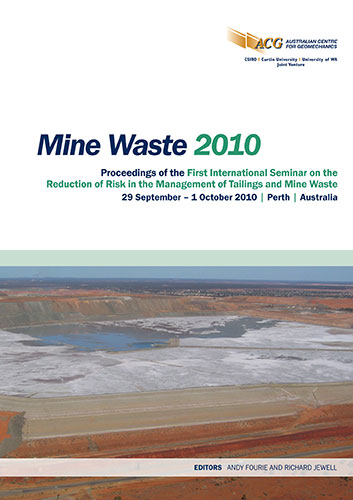An environmentally and economically attractive integrated landform for the storage of tailings and waste at the Randalls Gold Project in Western Australia

|
Authors: Williams, DA; Minard, TE |
DOI https://doi.org/10.36487/ACG_rep/1008_12_Williams
Cite As:
Williams, DA & Minard, TE 2010, 'An environmentally and economically attractive integrated landform for the storage of tailings and waste at the Randalls Gold Project in Western Australia', in R Jewell & AB Fourie (eds), Mine Waste 2010: Proceedings of the First International Seminar on the Reduction of Risk in the Management of Tailings and Mine Waste, Australian Centre for Geomechanics, Perth, pp. 129-143, https://doi.org/10.36487/ACG_rep/1008_12_Williams
Abstract:
The traditional approach that is commonly adopted for the management and storage of tailings and mine waste on gold mines in Western Australia usually results in the formation of numerous separate landforms. At the Randalls Gold Project, it has been possible to take advantage of the timing of overburden and waste removal from the open pit to create a full height tailings storage facility embedded within the waste stockpile to form a single integrated waste landform. A suitable location for waste and tailings storage was identified immediately adjacent to the open pit, and early geotechnical investigations revealed that appropriate materials are available within the pit overburden to construct engineered embankments that will safely contain the tailings. Tailings test work has indicated that the formation of a full height facility to about 20 m over about 5 years of production could be accommodated. Site investigation, characterisation and numerical modelling has demonstrated that seepage emanating from the landform will report to the open pit, which will act as a permanent ground water sink, thus limiting adverse impacts that are typically associated with seepage from mine waste landforms. Careful planning, scheduling, placement and treatment of waste removal ahead of mineral processing has therefore allowed for the economical development of an environmentally attractive integrated landform. Materials appropriate for the formation of a long term cover to the landform have been identified and stockpiled for use in rehabilitation and final landform protection and shaping.
References:
Australian National Committee on Large Dams (ANCOLD) (1999) Guideline on Tailings Dam Design, Construction
and Operation, October.
Department of Industry and Resources (DoIR) (1997) Safety Bund Walls Around Abandoned Open Pit Mines,
Department of Industry and Resources, Western Australia.
Department of Minerals and Energy (DME) (1999) Guidelines on the Safe Design and Operating Standards for Tailings
Storage, Department of Minerals and Energy, Western Australia.
Department of Minerals and Energy (DME) (2000) Water Quality Protection Guidelines No. 3, Mining and Mineral
Processing, Liners for Waste Containment, Department of Minerals and Energy, Western Australia.
An environmentally and economically attractive integrated landform for the storage of tailings D.A. Williams and T.E. Minard
and waste at the Randalls Gold Project in Western Australia
144 Mine Waste 2010, Perth, Australia
© Copyright 2025, Australian Centre for Geomechanics (ACG), The University of Western Australia. All rights reserved.
View copyright/legal information
Please direct any queries or error reports to repository-acg@uwa.edu.au
View copyright/legal information
Please direct any queries or error reports to repository-acg@uwa.edu.au